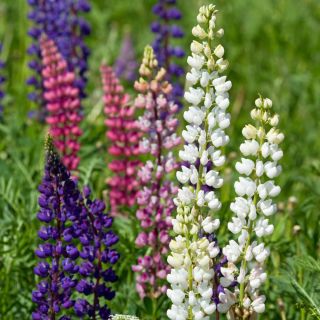Lupine, particularly the Russell variety if available, is an exceptionally striking perennial plant, ensuring a garden filled with vibrant, multi-coloured blooms. The plant reaches a height of 30-50 cm, with a sturdy stem topped by an impressive, elongated flower spike. This seed mix offers a rich palette of colours, bringing dynamism and diversity to any flower bed. Lupins thrive in both group plantings and as cut flowers, making them a versatile choice for garden enthusiasts. In the second year of growth, the plant fully reveals its aesthetic qualities, providing satisfaction through its cultivation and blossoming.
Sowing
Lupine is best sown directly into the ground to avoid the stress of transplanting. Preparing the soil adequately will ensure optimal conditions for seed germination. Regular watering and protection from weeds will support the development of young plants.
Sowing Depth
Sow lupine seeds at a depth of 0.5-1 cm. This depth provides the seeds with the necessary moisture and protection from wind and birds. Shallow sowing also facilitates easier emergence of sprouts through the soil surface.
Direct Sowing Period
The optimal time to sow lupine seeds directly into the ground is from April to June. Choosing this period supports proper plant development, allowing it to make full use of the growing season.
Plant Spacing
For optimal growth, plant lupines with a spacing of 30x50 cm. This arrangement allows for the free development of roots and leaves, ensuring each plant has access to essential nutrients and light.
Site Conditions
Lupine prefers sunny or slightly shaded sites, promoting abundant flowering. The soil should be well-drained, moderately moist, and slightly acidic. The plant performs well in sandy and poor soils, enriching them with nitrogen through symbiosis with root nodule bacteria. Regular weeding and moderate watering are essential care practices to provide lupine with optimal growth conditions.
Growing Tips
Lupine is a low-maintenance plant, making it an ideal choice for novice gardeners. Monitor soil moisture, especially during dry spells, and remove spent flower spikes to encourage further blooming. Regular organic fertilisation will support the plant's lush development.
Plant Height
Lupine grows to a height of 30-50 cm. Its sturdy stem and elongated flower spikes give it an elegant appearance, making it a superb choice for any garden.
Flowering Period
Lupine flowers from June to August, offering a variety of colours and flower shapes. This is a special time when the garden comes alive with a riot of colours and scents.
Usage
Lupine is perfect for flower beds and group plantings. Its multi-coloured flowers make a splendid garden decoration, and its suitability as a cut flower allows for creating beautiful bouquets. This plant also attracts bees and butterflies, contributing to increased biodiversity in the garden.
Resistance to Diseases
Lupine demonstrates high resistance to most diseases, making it easy to grow. Rarely attacked by pests, it can be safely cultivated in various climatic conditions.
Good to Know
Lupine enriches the soil with nitrogen thanks to its symbiosis with root nodule bacteria, making it an excellent precursor for other plants. Its cultivation contributes to improving soil structure and fertility. This plant not only adorns gardens but also supports their ecosystem.
Why Buy from Garden Seeds Market
The Garden Seeds Market offers seeds of the highest quality, which have undergone thorough laboratory testing. The high quality of products is confirmed by satisfied customers, and fast delivery ensures that seeds quickly reach your garden. Transaction security and reliability are our shop's priorities, guaranteeing satisfaction with your purchases.
Package contains 2 g of seeds. The package includes information on cultivation guidelines and the sowing expiry date.


















